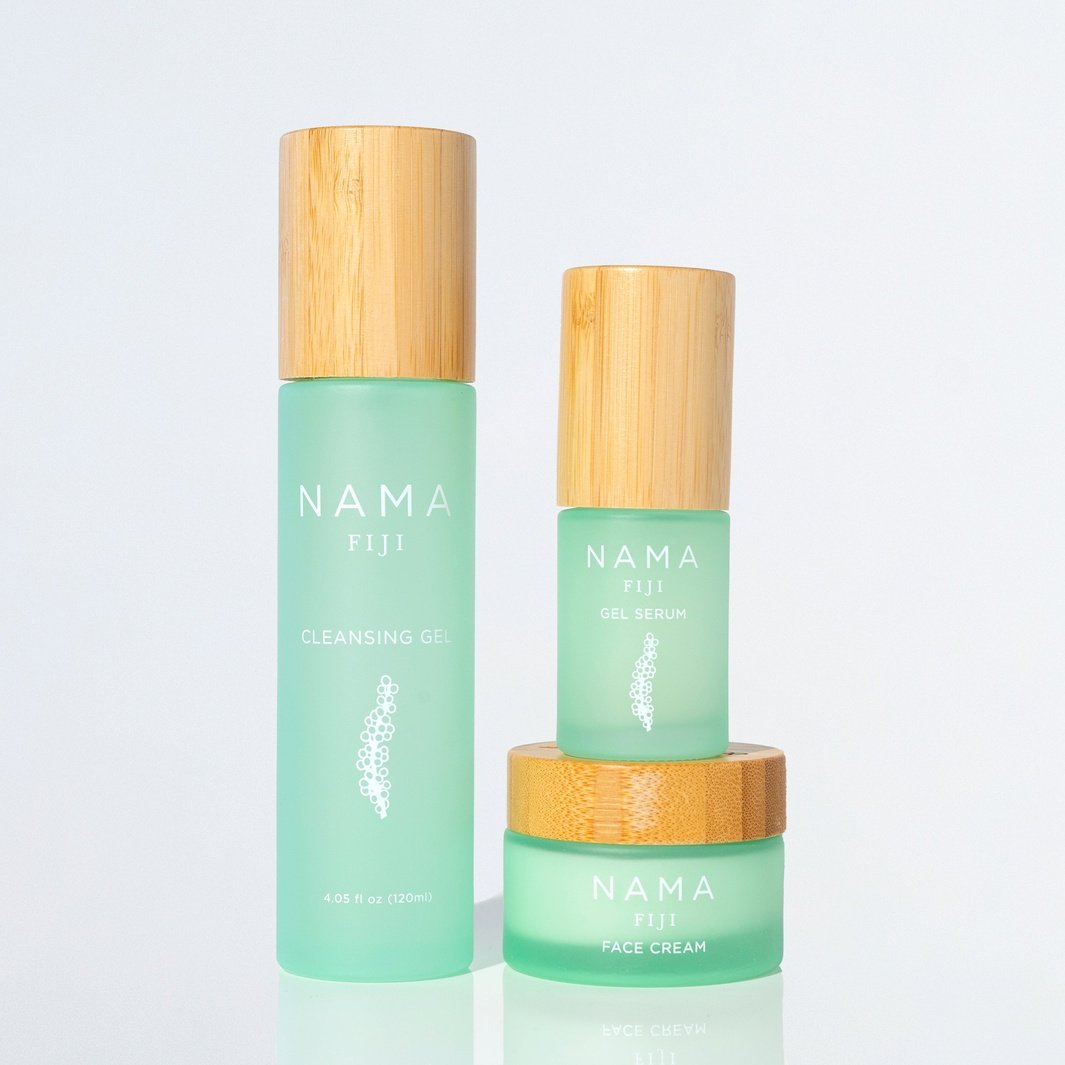Nurturing Our Planet and Your Skin
Nama Fiji has long been a sustainable business in the Fijian Islands, but as we work to expand across the globe we're looking to make improvements where we can, and minimize our negative impact on the planet. While on our sustainability journey, we've decided to update our existing post-consumer recycled plastic packaging to a new, more sustainable, alternative. There are many different types, shapes, and sizes of packaging for skincare and we've narrowed it down based on a few key criteria including cost, local availability, and ease of use. But here's our dilemma: should we opt for sleek aluminum, timeless glass, or rustic craft paper?

Each material has its own set of advantages and considerations regarding sustainability, manufacturing, and shipment. Aluminum offers excellent recyclability and lightweight properties, making it an ideal choice for reducing carbon emissions during transportation. Glass, on the other hand, boasts unmatched durability and recyclability, perfect for creating luxurious skincare experiences while minimizing environmental impact. Meanwhile, craft paper packaging provides a charming, eco-friendly alternative, appealing to those who prioritize biodegradability and a rustic aesthetic. There's so many positives and negatives for each, we wanted to lay them out and get your take on what's best.
First, let's start with our Current Packaging
Our Discovery Kits are comprised of 8 15ml tubes showcasing our retail skincare products, and those tubes are made from PCR plastic. Post-Consumer Recycled (PCR) plastic is a pioneer in the quest for sustainable packaging solutions. When brands utilize PCR plastic, they can give new life to old materials, diverting them from landfills and reducing the demand for virgin plastic. But the journey doesn't end there. Continuous innovation in packaging technology allows the industry to further enhance the sustainability of PCR plastic tubes, which includes exploring biodegradable additives to optimizing tube designs for easier recycling. However at the end of the day, recycled plastic is still plastic, and we’re trying to eliminate as much as we can from our manufacturing process.

Now, onto our first option: Aluminum Packaging
Aluminum tubes are a popular choice for skincare packaging and are either made of pure aluminum or PCR-lined aluminum cylinders. These sheets are fused into different sized tubes to package creams, lotions, gels, and ointments.
| PROS | CONS |
| Protective: Aluminum provides a barrier against light, moisture, and air, which helps preserve the integrity of the skincare product and prolong its shelf life. | Not Biodegradable: While aluminum is recyclable, it is not biodegradable. Improper disposal can lead to environmental pollution if not recycled correctly, which is much larger concern in certain regions (like the states) compared to others (such as Europe). |
| Recyclable: Aluminum is highly recyclable, and the recycling process consumes less energy compared to producing new aluminum. This makes aluminum tubes an eco-friendly option. | Leaky Cap: Aluminum tubes may have limited design options compared to other materials, which can impact ease of use and effectiveness. Certain products, (including our gel serum) that have a high liquid content can leak through the screwtop seal, both wasting valuable product and making a mess across your toiletry bag. |
| Lightweight: Aluminum tubes are lightweight, which can reduce transportation emissions and make them convenient for travel. |
Our next option: Glass Packaging
Glass and bamboo tubes are a more common luxury option for skincare packaging, and typically consist of a glass body of varied volumes and a lid made from sustainable bamboo. Glass tubes are incredibly versatile, protective, and aesthetic, and can also protect against light pollution if frosted or darker in color.
| PROS | CONS |
| Recyclable: Glass is 100% recyclable and can be recycled indefinitely without losing quality, making glass tubes a sustainable choice. | Cost: Glass and bamboo packaging is more expensive than the existing PCR tubes, and more expensive to ship, which may require pricing adjustments. |
| Protective: Glass provides excellent protection against light, moisture, and air, helping to maintain the potency and efficacy of the skincare product. It’s inert nature also prevents the product from absorbing any chemicals leeched out of the packaging itself; the materials used to package your skincare can end up in the formula the longer the product is in contact with the packaging. | Fragility: Glass tubes are more prone to breakage than other packaging materials, which can increase the risk of product damage during transportation and handling and may require more interior packing waste to protect. There’s also the potential risk to the consumer; we don’t want anyone getting hurt on broken glass! |
| Aesthetic: Glass packaging absolutely exudes a luxurious and premium feel, enhancing those ever-important lifestyle shots and drawing a small smile across your face each skincare routine | Heavier Weight: Glass packaging is heavier than aluminum or craft paper, which may lead to higher transportation emissions and costs. |
and our final option: Craft Paper Packaging
Craft paper pouches are a sustainable and eco-friendly option for skincare packaging that are typically made from biodegradable and compostable materials such as Kraft paper, which is derived from wood pulp.
| PROS | CONS |
| Biodegradable: Craft paper pouches are biodegradable and compostable, making them an eco-friendly option that reduces landfill waste, and something easy to dispose of across all regions. | Less Protective: Craft paper pouches may offer less protection against light, moisture, and air compared to other materials, which could impact the stability and shelf life of the skincare product. |
| Lightweight: Similar to aluminum tubes, craft paper pouches are lightweight, which can lower transportation emissions and reduce carbon footprint. |
Durability Concerns: Craft paper pouches may be less durable than other packaging options, especially if exposed to water or rough handling during transportation. The last thing we want is for any pouches to get wet and slowly dissolve from the outside in. *Similarly to the aluminum tubes, using PCR plastic to line the craft paper is a workable solution to mitigate durability issues. |
| Customizable: Craft paper pouches offer flexibility in design and printing, which allows us to easily showcase our branding and print directly at our facility in Nadi, Fiji. |
So what's your take? Which do you prefer and why? Do you have better suggestions? We've looked at sugar cane, clay, cellulose, even seaweed-based plastics to try and find something beautiful, easy to use, and good for the planet; but we're always willing to learn more!

Comment below, or tag us on instagram or tiktok (@namafiji) and show us your favorite sustainable solutions!





![Discovery Kit [Cosmoprof Exclusive]](http://www.nama-fiji.com/cdn/shop/files/DiscKit1.jpg?v=1729833258&width=900)

I like the current packaging you currently use for your products. I have been purchasing the gel face wash and eye cream and occasionally the gel serum. I like all the packaging it comes in and feel you have the best packaging that is recyclable. I would not ever use the aluminum tubes I have used those from companies such as The Body Shop and they always leak and tear so I would recommend not ever using those. I think you have already done a fantastic job with the packaging I love the glass and bamboo lids. I think one thing I would change is maybe making instead of an introductory kit a travel kit because I love to take your products when I travel but have to find other containers to put my products in.
Leave a comment